Small overlap front: driver-side
Rating applies to 2015-23 models
Tested vehicle: 2016 Dodge Challenger R/T 2-door
The Dodge Challenger was re-introduced in the 2009 model year after last being offered as a Mitsubishi-built sporty car in the 1983 model year. (The iconic Challenger performance car was offered during the 1970-74 model years.) Beginning with 2015 models, the car's body structure, door trim, and instrument panel were modified and the side curtain airbags were lengthened to improve occupant protection in both frontal and side crashes.
| Evaluation criteria | Rating |
|---|---|
| Structure and safety cage | |
| Driver injury measures | |
| Head/neck | |
| Chest | |
| Hip/thigh | |
| Lower leg/foot | |
| Driver restraints and dummy kinematics | |
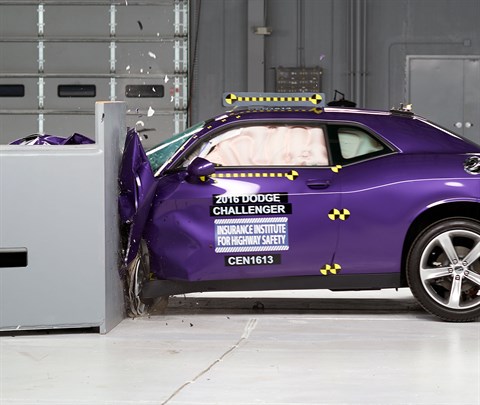
Action shot taken during the small overlap frontal crash test.
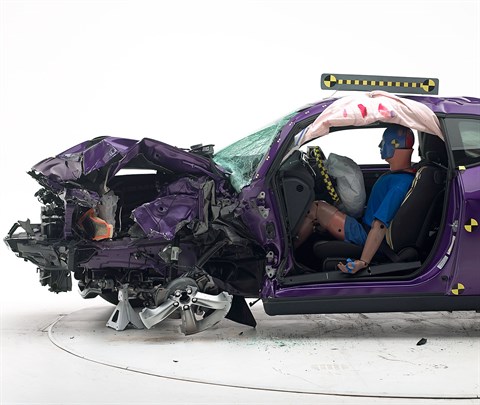
The dummy's position in relation to the door frame, steering wheel, and instrument panel after the crash test indicates that the driver's survival space was not maintained well.
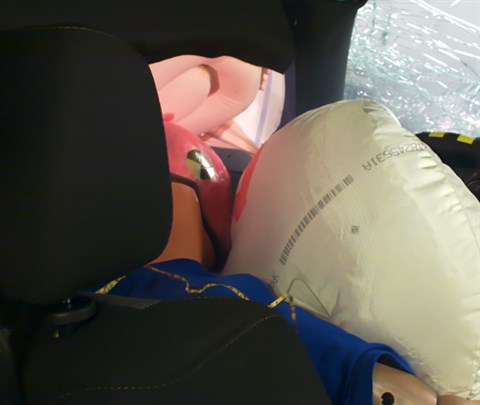
The dummy's head contacted the frontal airbag but then nearly slid off the left side, allowing the head to move toward the gap in coverage between the frontal and side curtain airbags.
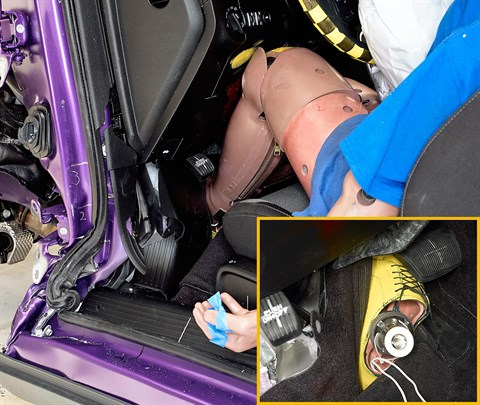
Intrusion was extensive. During the crash, the left front wheel was forced rearward and inward into the occupant compartment, and the severely buckled toepan trapped the dummy’s left foot. The dummy's leg had to be unbolted from the foot in order to free it (inset).
Moderate overlap front: original test
Rating applies to 2015-23 models
Tested vehicle: 2016 Dodge Challenger R/T 2-door
The Dodge Challenger was re-introduced in the 2009 model year after last being offered as a Mitsubishi-built sporty car in the 1983 model year. (The iconic Challenger performance car was offered during the 1970-74 model years.) Beginning with 2015 models, the car's body structure, door trim, and instrument panel were modified and the side curtain airbags were lengthened to improve occupant protection in both frontal and side crashes.
| Evaluation criteria | Rating |
|---|---|
| Overall evaluation | |
| Structure and safety cage | |
| Driver injury measures | |
| Head/neck | |
| Chest | |
| Leg/foot, left | |
| Leg/foot, right | |
| Driver restraints and dummy kinematics | |

Action shot taken during the moderate overlap frontal crash test.
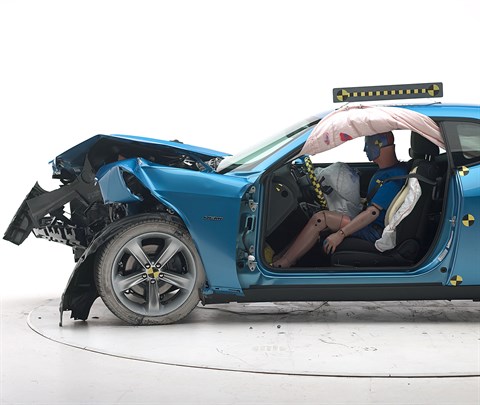
The dummy's position in relation to the steering wheel and instrument panel after the crash test indicates that the driver's survival space was maintained very well.
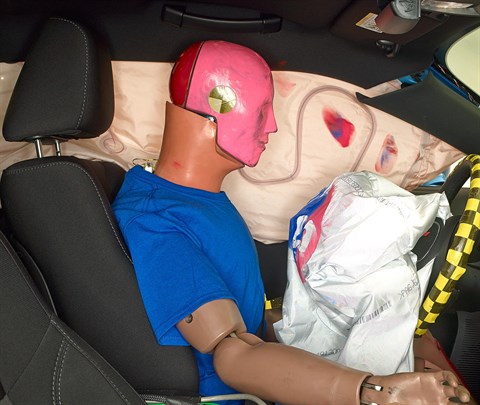
Smeared greasepaint indicates where the dummy's head contacted the side curtain airbag during forward movement and rebound.
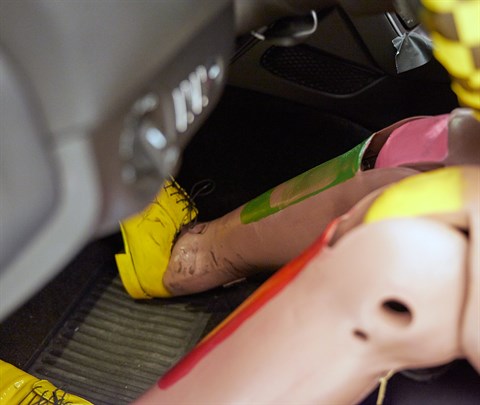
Forces on the right lower leg were just high enough to indicate the possibility of injuries.
Side: original test
Rating applies to 2015-23 models
Tested vehicle: 2016 Dodge Challenger R/T 2-door
The Dodge Challenger was re-introduced in the 2009 model year after last being offered as a Mitsubishi-built sporty car in the 1983 model year. (The iconic Challenger performance car was offered during the 1970-74 model years.) Beginning with 2015 models, the car's body structure, door trim, and instrument panel were modified and the side curtain airbags were lengthened to improve occupant protection in both frontal and side crashes.
| Evaluation criteria | Rating |
|---|---|
| Overall evaluation | |
| Structure and safety cage | |
| Driver injury measures | |
| Head/neck | |
| Torso | |
| Pelvis/leg | |
| Driver head protection | |
| Rear passenger injury measures | |
| Head/neck | |
| Torso | |
| Pelvis/leg | |
| Rear passenger head protection | |

View of the vehicle and barrier just after the crash test.
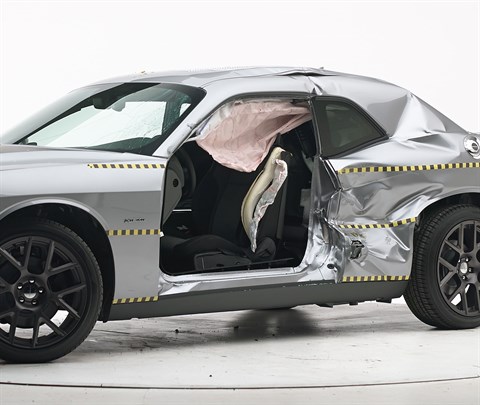
View of the vehicle after the crash with door removed, showing the side airbags and damage to the occupant compartment.
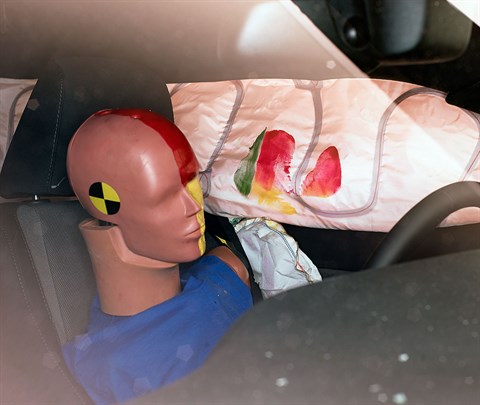
Smeared greasepaint shows where the driver dummy's head was protected from being hit by hard structures by the side curtain airbag.
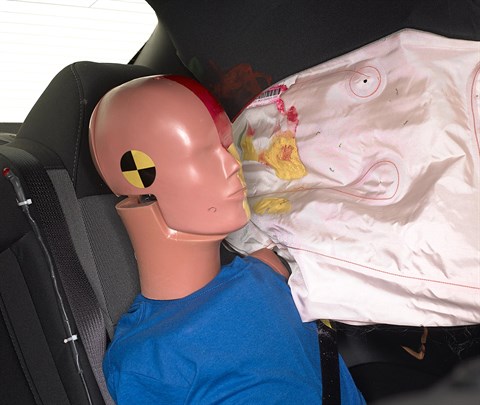
Smeared greasepaint shows where the rear passenger dummy’s head was protected by the side airbag.
Roof strength
Rating applies to 2015-23 models
Tested vehicle: 2016 Dodge Challenger R/T 2-door
| Overall evaluation | |
|---|---|
| Curb weight | 4,149 lbs |
| Peak force | 15,240 lbs |
| Strength-to-weight ratio | 3.67 |
Head restraints & seats
Seat type: Power cloth seat
| Overall evaluation | |
|---|---|
| Dynamic rating | |
| Seat/head restraint geometry |
About the head restraint & seat test
Currently, IIHS tests apply only to front seats.
Front crash prevention: vehicle-to-vehicle
Child seat anchors
Rating applies to 2016-20 models
| Evaluation criteria | Rating |
|---|---|
| Overall evaluation | |
| Vehicle trim | R/T |
| Seat type | cloth |
This vehicle has 3 rear seating positions with complete child seat attachment (LATCH) hardware.
| Evaluation criteria | Rating |
|---|---|
| Overall evaluation | |
| Vehicle trim | R/T |
| Seat type | cloth |
| Rating icon | Rating |
|---|---|
| G | Good |
| A | Acceptable |
| M | Marginal |
| P | Poor |
| Seating positions that rely on borrowed lower anchors or have only a tether anchor available are not rated. | |
thether anchor symbol | Tether anchor |
lower anchor symbol | Lower anchors |
| Lower anchor(s) can be borrowed from adjacent positions(s) | |
| No hardware available |
Details by seating position
| Position | Rating |
|---|---|
| 1 | |
| Tether anchor | |
| easy-to-find location | |
| no other hardware could be confused for anchor | |
| Lower anchors | |
| too deep in seat | |
| not too much force needed to attach | |
| easy to maneuver around anchors | |
| 2 | |
| Tether anchor | |
| easy-to-find location | |
| no other hardware could be confused for anchor | |
| Lower anchors | |
| too deep in seat | |
| too much force needed to attach | |
| difficult to maneuver around anchors | |
| 3 | |
| Tether anchor | |
| easy-to-find location | |
| no other hardware could be confused for anchor | |
| Lower anchors | |
| too deep in seat | |
| not too much force needed to attach | |
| easy to maneuver around anchors |
